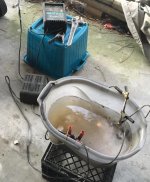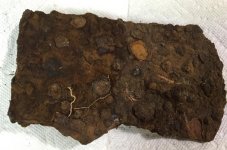Chipk
Elite Member
Recently found a large, very rusty axe head. Due to research and circumstances, I am convinced it dates to the 1700s. I want to clean it up.
I watched a number of YouTube videos and set up my equipment. I used a car charger and plugged it in. In all the videos I watched, bubbling began immediately. Nope. After several hours and no bubbles nor scum on the surfaceI switched the leads and let it run 24 hours. Nothing. So I switched car chargers. Still nothing. So I rewired the axe and refreshed the washing soda. Nada.
So today I completely recooked up everything. I replaced the copper wire with a galvanized bolt running through the handle opening and used washers and nuts to secure it. Put it in a deeper container and replaced the soda water. Still nothing.
Finally I attached BOTH car chargers. Trying to put as strong a signal as possible. But now I worried I may ruin the chargers or start a fire. BUT it does seem I am finally getting a reaction.
Has anybody used two or more chargers?
I watched a number of YouTube videos and set up my equipment. I used a car charger and plugged it in. In all the videos I watched, bubbling began immediately. Nope. After several hours and no bubbles nor scum on the surfaceI switched the leads and let it run 24 hours. Nothing. So I switched car chargers. Still nothing. So I rewired the axe and refreshed the washing soda. Nada.
So today I completely recooked up everything. I replaced the copper wire with a galvanized bolt running through the handle opening and used washers and nuts to secure it. Put it in a deeper container and replaced the soda water. Still nothing.
Finally I attached BOTH car chargers. Trying to put as strong a signal as possible. But now I worried I may ruin the chargers or start a fire. BUT it does seem I am finally getting a reaction.
Has anybody used two or more chargers?



